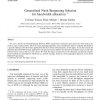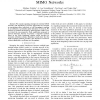135
Voted
ICIP
2010
IEEE
14 years 10 months ago
2010
IEEE
We propose a game-theory-based cross-layer optimization scheme for wireless Direct Sequence Code Division Multiple Access (DSCDMA) visual sensor networks. The scheme uses the Nash...
92
Voted
CN
2006
15 years 21 days ago
2006
For over a decade, the Nash Bargaining Solution (NBS) concept from cooperative game theory has been used in networks to share resources fairly. Due to its many appealing propertie...
108
Voted
GLOBECOM
2009
IEEE
15 years 4 months ago
2009
IEEE
We consider a problem where two selfish cognitive radio users try to share two channels on which they each have potentially different valuations. We first formulate the problem as ...
118
click to vote
HICSS
2003
IEEE
15 years 6 months ago
2003
IEEE
Microeconomics offer a far developed theory on the subject of rational choice. This theory is applied to a multi-agent system, which has been modeled in order to establish schedul...
116
Voted
ATAL
2005
Springer
15 years 6 months ago
2005
Springer
Negotiation techniques have been demonstrated to be effective in solving complex multi-objective problems. When the optimization process operates on continuous variables, it can b...
121
Voted
ICC
2007
IEEE
15 years 7 months ago
2007
IEEE
— There is a need for new spectrum access protocols that are opportunistic, flexible and efficient, yet fair. Game theory provides a framework for analyzing spectrum access, a ...
101
Voted
GLOBECOM
2007
IEEE
15 years 7 months ago
2007
IEEE
—We examine signaling strategies for wireless MIMO networks with interference. Previous approaches have focused on maximizing either individual or total throughput, resulting in ...
140
Voted
ICIP
2007
IEEE
16 years 2 months ago
2007
IEEE
Multi-user collusion is an cost-effective attack against digital fingerprinting, in which a group of attackers collectively undermine the traitor tracing capability of digital fin...






